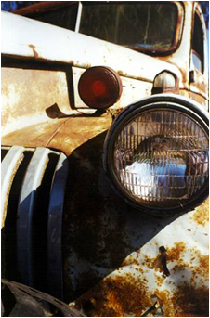
The first step is to find an inspiring reference photo. I prefer to use digital pictures because I can resize and crop before printing so they are in proportion to my watercolor paper. I also often print detailed portions of the scene (e.g., the house and lupine) so that I can see the details clearly. Having my laptop nearby also helps see details in more vivid color than in print materials.
It's important to decide right up front which elements should stay and which should go. Think about this before you begin drawing. The lupine in this
hoto isn't at its best, so I will enhance it with fresh blooms. I'll also add sailboats to the horizon to add depth and interest to the left side of the painting. The house will look better with an open summer porch, allowing the sea breeze to flow through, so I'll modify that as well.
I use blue painter's tape to affix the paper to an art board. As this will be a full-sheet painting, I'll use 300lb Arches cold-press paper with a 24x36" plexiglass support. Some artists soak and staple their paper, but with paper this heavy, tape works fine for me and
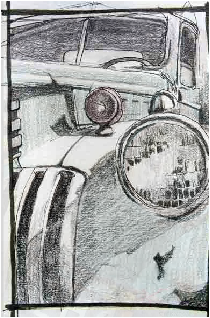
The first step is to find an inspiring reference photo. I prefer to use digital pictures because I can resize and crop before printing so they are in proportion to my watercolor paper. I also often print detailed portions of the scene (e.g., the house and lupine) so that I can see the details clearly. Having my laptop nearby also helps see details in more vivid color than in print materials.
It's important to decide right up front which elements should stay and which should go. Think about this before you begin drawing. The lupine in this
hoto isn't at its best, so I will enhance it with fresh blooms. I'll also add sailboats to the horizon to add depth and interest to the left side of the painting. The house will look better with an open summer porch, allowing the sea breeze to flow through, so I'll modify that as well.
I use blue painter's tape to affix the paper to an art board. As this will be a full-sheet painting, I'll use 300lb Arches cold-press paper with a 24x36" plexiglass support. Some artists soak and staple their paper, but with paper this heavy, tape works fine for me and
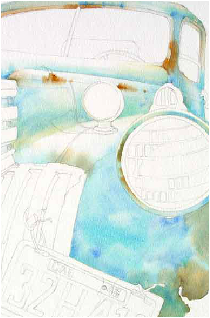
The first step is to find an inspiring reference photo. I prefer to use digital pictures because I can resize and crop before printing so they are in proportion to my watercolor paper. I also often print detailed portions of the scene (e.g., the house and lupine) so that I can see the details clearly. Having my laptop nearby also helps see details in more vivid color than in print materials.
It's important to decide right up front which elements should stay and which should go. Think about this before you begin drawing. The lupine in this
hoto isn't at its best, so I will enhance it with fresh blooms. I'll also add sailboats to the horizon to add depth and interest to the left side of the painting. The house will look better with an open summer porch, allowing the sea breeze to flow through, so I'll modify that as well.
I use blue painter's tape to affix the paper to an art board. As this will be a full-sheet painting, I'll use 300lb Arches cold-press paper with a 24x36" plexiglass support. Some artists soak and staple their paper, but with paper this heavy, tape works fine for me and
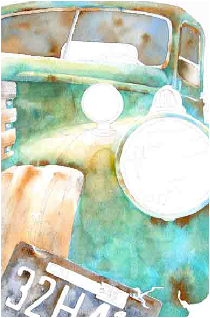
The first step is to find an inspiring reference photo. I prefer to use digital pictures because I can resize and crop before printing so they are in proportion to my watercolor paper. I also often print detailed portions of the scene (e.g., the house and lupine) so that I can see the details clearly. Having my laptop nearby also helps see details in more vivid color than in print materials.
It's important to decide right up front which elements should stay and which should go. Think about this before you begin drawing. The lupine in this
hoto isn't at its best, so I will enhance it with fresh blooms. I'll also add sailboats to the horizon to add depth and interest to the left side of the painting. The house will look better with an open summer porch, allowing the sea breeze to flow through, so I'll modify that as well.
I use blue painter's tape to affix the paper to an art board. As this will be a full-sheet painting, I'll use 300lb Arches cold-press paper with a 24x36" plexiglass support. Some artists soak and staple their paper, but with paper this heavy, tape works fine for me and
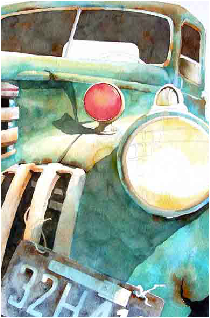
The first step is to find an inspiring reference photo. I prefer to use digital pictures because I can resize and crop before printing so they are in proportion to my watercolor paper. I also often print detailed portions of the scene (e.g., the house and lupine) so that I can see the details clearly. Having my laptop nearby also helps see details in more vivid color than in print materials.
It's important to decide right up front which elements should stay and which should go. Think about this before you begin drawing. The lupine in this
hoto isn't at its best, so I will enhance it with fresh blooms. I'll also add sailboats to the horizon to add depth and interest to the left side of the painting. The house will look better with an open summer porch, allowing the sea breeze to flow through, so I'll modify that as well.
I use blue painter's tape to affix the paper to an art board. As this will be a full-sheet painting, I'll use 300lb Arches cold-press paper with a 24x36" plexiglass support. Some artists soak and staple their paper, but with paper this heavy, tape works fine for me and
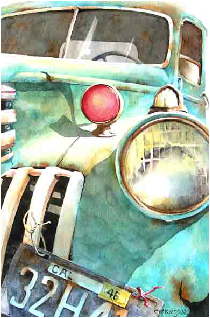
The first step is to find an inspiring reference photo. I prefer to use digital pictures because I can resize and crop before printing so they are in proportion to my watercolor paper. I also often print detailed portions of the scene (e.g., the house and lupine) so that I can see the details clearly. Having my laptop nearby also helps see details in more vivid color than in print materials.
It's important to decide right up front which elements should stay and which should go. Think about this before you begin drawing. The lupine in this
hoto isn't at its best, so I will enhance it with fresh blooms. I'll also add sailboats to the horizon to add depth and interest to the left side of the painting. The house will look better with an open summer porch, allowing the sea breeze to flow through, so I'll modify that as well.
I use blue painter's tape to affix the paper to an art board. As this will be a full-sheet painting, I'll use 300lb Arches cold-press paper with a 24x36" plexiglass support. Some artists soak and staple their paper, but with paper this heavy, tape works fine for me and
© 2025 Stephanie Sodel. All rights reserved.